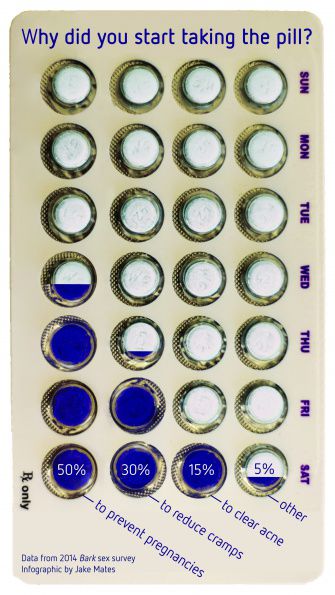According to the January Bark survey, the rate of teenagers using birth control pills has risen in recent years. Teenage girls use the pill not only to prevent pregnancy, but also to help with negative side effects of puberty.
When looking only at girls who use some form of birth control, the pill is the most popular form of contraception at 40.7 percent. One in four Redwood girls uses the pill whether or not they have had sex. This is up from 1982, when only 31 percent of girls on birth control used the pill.

Among girls who use the pill, only half were originally prescribed the pill to prevent pregnancy. Instead, 15 percent were prescribed the pill to clear acne, 30 percent to reduce cramps, and 5 percent for another reason.
Pediatrician Dr. Suzanne Christie often prescribes the birth control pill to her teenage patients. Though Christie said she most commonly prescribes the birth control pill to sexually active teenagers, she also prescribes the pill for other reasons such as severe acne, cramps, or irregular or heavy periods.
“Most of the pills we use are the combination pills, so estrogen and progestin pills, and they come in different strengths,” Christie said. “So I always like to start my girls on the lowest possible hormone levels as I can. And then we can go up if girls continue to break through bleeding or having symptoms that aren’t tolerable.”
Anonymous junior “Amanda” was prescribed the birth control pill by her doctor to help with bad cramps and another separate medical issue. According to Amanda, the pill has helped get rid of her cramps, as well as clear her skin and regulate her periods.
Anonymous senior “Megan” was initially prescribed the birth control pill by her dermatologist to clear up her acne and said it has been very effective.
“My dermatologist recommended it because it was the last step before going on Accutane, which is an acne medication that’s very harsh and can be dangerous,” Megan said. “So, I went on it and it’s been very successful.”
According to Christie, the pill is often prescribed in combination with Accutane as well for teenagers with severe acne.
“I prescribe the pill to girls with severe acne who are unresponsive to all regular treatments and the dermatologist wants to put them on a medicine called Accutane,” Christie said. “That medicine can have severe effects to a fetus during fetal growth, and so the standard of care for girls going on that medicine is that they go on birth control at the same time, even with a non-sexually active girl.”
While the pill is effective at preventing pregnancy, clearing up acne, and getting rid of cramps, it does not come without its side effects. According to Planned Parenthood, the pill can cause nausea, sore breasts, headaches, and irregular bleeding.
When Amanda began taking the pill, she noticed a number of negative side effects.
“I got nauseous a lot,” Amanda said. “There would be these things were I wasn’t really hungry and I would get nausea. If I forgot to take it for a day or two days I would feel light headed and I needed to throw up.”
According to Christie, many teenagers also experience weight gain while taking the pill. Amanda mentioned having to watch her weight after starting the pill.
“It does make you gain weight,” Amanda said. “Most people will gain six to eight pounds. The word I think is bloated. It’s not like you feel fat, it’s just like there is more water. It feels more like that.”
Megan, however, did not notice any major side effects that came with the pill.
“There’s sometimes weight gain but I think that’s because it makes you hungrier, so I think you can control that,” Megan said. “I do have a friend who went on it and it had a negative effect on her. It made her cramps worse, but it definitely depends on the individual. For me, it worked very well and I would recommend other people try it.”
Both Megan and Amanda were prescribed the pill by their doctors without much talk about alternative forms of birth control, but said that they will probably stay with the pill because of its positive effects.
“I think most people gravitate towards the pill because it’s kind of easy,” Amanda said. “It’s nothing physical. You just take a pill.”
Although the pill is the most popular form of birth control among teenagers, other forms are used as well. Of the girls at Redwood who take birth control, 14.8 percent use an implant, 3.7 percent take a patch or shot, and 11.1 percent use another form of birth control.
Christie said that she most commonly prescribes the birth control pill to teenagers because it is so convenient, but that she would prescribe an alternate form of birth control if a teenager experienced negative side effects on the pill or couldn’t remember to take it every day.
“There’s the Nuvaring, which has gained popularity. Some teenagers like that and find that effective. There’s some of the longer-acting injections like Depo-Provera,” Christie said. “With the Nuvaring, for example, you would have fewer systemic side effects. There are still hormones, but they are embedded more locally, so it’s not quite as heavily absorbed as swallowing a pill and having it systemically absorbed.”






